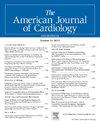Diagnosis and Treatment of Unrecognized Spontaneous Coronary Artery Dissection in Young Women Presenting With an Acute Coronary Syndrome
IF 2.1
3区 医学
Q2 CARDIAC & CARDIOVASCULAR SYSTEMS
引用次数: 0
Abstract
Spontaneous coronary artery dissection (SCAD) is often overlooked as a cause of acute coronary syndrome (ACS), particularly in young women. SCAD requires distinct management, underscoring the importance of its timely and accurate diagnosis for effective treatment. This study aims to evaluate the frequency of SCAD underdiagnosis in young women with ACS and pinpoints potential SCAD indicators. All consecutive women ≤55 years with ACS who underwent coronary angiography (CAG) at our tertiary center from 2012 to 2024, were included. Clinical data at baseline and follow-up were retrospectively collected. All coronary angiography's (CAGs) were reviewed for SCAD-signs using the Yip-Saw criteria. Accurately diagnosed SCAD patients were compared to those with initially unrecognized SCAD and patients with other ACS causes. Of 394 patients (mean age 48.4 ± 5.8 years) evaluated, 23% (n = 92) had SCAD, but 41% (n = 38) were not initially correctly diagnosed. SCAD type 3 was most often missed. SCAD patients were younger and more frequently lacked traditional cardiovascular risk factors. They also showed higher coronary tortuosity scores, which were significantly associated with SCAD in multivariate analysis. Invasively treated SCAD patients received more stents than non-SCAD patients, largely due to hematoma extension. Follow-up revealed fewer atherosclerotic ACS in SCAD patients, with recurrent SCAD occurring only in undiagnosed cases. In conclusion, underdiagnosis of SCAD in young women with ACS is common and leads to inappropriate treatment, highlighting the need for increased awareness and improved diagnostic approaches. Young ACS patients with minimal cardiovascular risk factors and high coronary tortuosity scores should be carefully evaluated for SCAD.
以急性冠状动脉综合征为表现的年轻女性自发性冠状动脉剥离的诊断和治疗。
自发性冠状动脉剥离(SCAD)作为急性冠状动脉综合征(ACS)的一个原因经常被忽视,尤其是在年轻女性中。SCAD需要不同的管理,强调其及时和准确的诊断对有效治疗的重要性。本研究旨在评估年轻ACS女性SCAD漏诊的频率,并确定潜在的SCAD指标。所有≤55岁的ACS患者于2012年至2024年在我们的三级中心接受冠状动脉造影(CAG)检查。回顾性收集基线和随访时的临床资料。使用Yip-Saw标准对所有cag进行scad -体征检查。将准确诊断的SCAD患者与最初未被识别的SCAD患者和其他ACS原因的患者进行比较。在394例患者(平均年龄48.4±5.8岁)中,23% (n=92)患有SCAD,但41% (n=38)最初未被正确诊断。SCAD 3型最常被遗漏。SCAD患者更年轻,更经常缺乏传统的心血管危险因素。在多变量分析中,他们也显示出更高的冠状动脉扭曲评分,这与SCAD显著相关。有创治疗的SCAD患者比非SCAD患者接受更多的支架,主要是由于血肿扩展。随访发现SCAD患者中动脉粥样硬化性ACS较少,复发SCAD仅发生在未确诊的病例中。总之,年轻ACS女性对SCAD的诊断不足是常见的,并导致不适当的治疗,强调需要提高认识和改进诊断方法。心血管危险因素最小且冠状动脉扭曲评分高的年轻ACS患者应仔细评估SCAD。
本文章由计算机程序翻译,如有差异,请以英文原文为准。
求助全文
约1分钟内获得全文
求助全文
来源期刊

American Journal of Cardiology
医学-心血管系统
CiteScore
4.00
自引率
3.60%
发文量
698
审稿时长
33 days
期刊介绍:
Published 24 times a year, The American Journal of Cardiology® is an independent journal designed for cardiovascular disease specialists and internists with a subspecialty in cardiology throughout the world. AJC is an independent, scientific, peer-reviewed journal of original articles that focus on the practical, clinical approach to the diagnosis and treatment of cardiovascular disease. AJC has one of the fastest acceptance to publication times in Cardiology. Features report on systemic hypertension, methodology, drugs, pacing, arrhythmia, preventive cardiology, congestive heart failure, valvular heart disease, congenital heart disease, and cardiomyopathy. Also included are editorials, readers'' comments, and symposia.
 求助内容:
求助内容: 应助结果提醒方式:
应助结果提醒方式:


